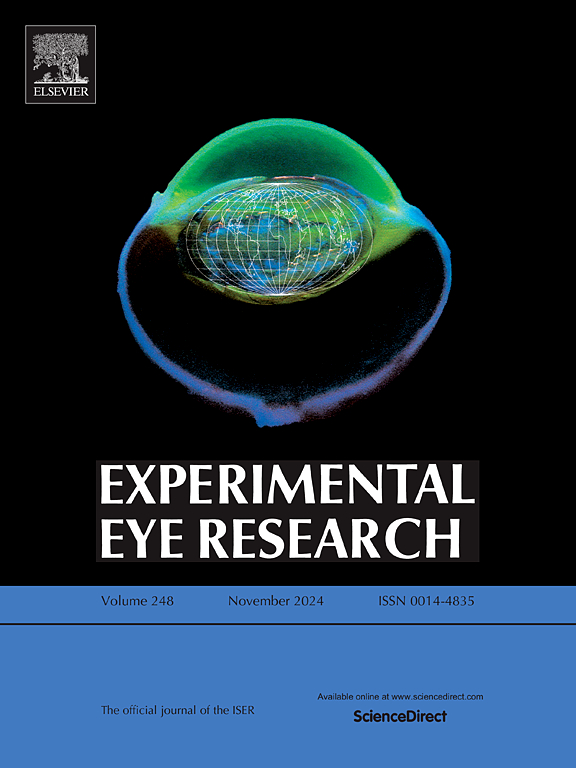CRB1 mutations cause structural and molecular defects in patient-derived retinal pigment epithelium cells
IF 3
2区 医学
Q1 OPHTHALMOLOGY
引用次数: 0
Abstract
Mutations in the CRB1 gene can cause retinitis pigmentosa (RP), Leber congenital amaurosis, and other retinopathies, with retinal pigment epithelium (RPE) being a primary affected cell type. However, the effects of CRB1 variants on RPE cells remain poorly defined. Here, for the first time, we report an in vitro model of patient-specific RPE cells carrying the CRB1 mutations (c.2249G > A and c.2809G > A) to study CRB1-associated RP disease. The patient-derived RPE cells exhibited irregular cell morphology, sparse apical microvilli, abnormal tight junctions, and reduced expression of RPE markers. We also observed that impaired barrier function and phagocytosis lead to increased apical-to-basal movement of fluorescent molecules in disease RPE cells. Notably, transcriptomic analysis revealed decreased expression of cell junction-related genes. In addition, aggregated RPE cells on polydimethylsiloxane (PDMS) microwells significantly enhanced RPE phenotype and cell survival, which was associated with anti-epithelial-mesenchymal transition, anti-aging, and anti-apoptosis. In this study, our results reveal that CRB1-mutated RPE cells generated using RP patient-derived iPSCs could recapitulate the genotype-phenotype features of the disease and provide insights into the pathogenesis of CRB1-associated RPE cells. In addition, our study developed a cell aggregation culture method based on PDMS microwell platforms for the production of highly active and mature iPSC-derived RPE cells.
CRB1突变导致患者源性视网膜色素上皮细胞的结构和分子缺陷。
CRB1基因突变可导致色素性视网膜炎(RP)、Leber先天性黑朦和其他视网膜病变,视网膜色素上皮(RPE)是主要受影响的细胞类型。然而,CRB1变异对RPE细胞的影响仍然不明确。在这里,我们首次报道了携带CRB1突变(c.2249G>A和c.2809G>A)的患者特异性RPE细胞的体外模型,以研究CRB1相关的RP疾病。患者源性RPE细胞形态不规则,顶端微绒毛稀疏,连接异常紧密,RPE标志物表达减少。我们还观察到,屏障功能受损和吞噬作用导致疾病RPE细胞中荧光分子从顶端到底部的运动增加。值得注意的是,转录组学分析显示细胞连接相关基因的表达减少。此外,聚二甲基硅氧烷(PDMS)微孔上聚集的RPE细胞显著提高了RPE表型和细胞存活率,这与抗上皮-间质转化、抗衰老和抗凋亡有关。在这项研究中,我们发现使用RP患者来源的iPSCs生成的crb1突变的RPE细胞可以概括该疾病的基因型-表型特征,并为crb1相关RPE细胞的发病机制提供见解。此外,我们的研究开发了一种基于PDMS微孔平台的细胞聚集培养方法,用于生产高活性和成熟的ipsc衍生的RPE细胞。
本文章由计算机程序翻译,如有差异,请以英文原文为准。
求助全文
约1分钟内获得全文
求助全文
来源期刊

Experimental eye research
医学-眼科学
CiteScore
6.80
自引率
5.90%
发文量
323
审稿时长
66 days
期刊介绍:
The primary goal of Experimental Eye Research is to publish original research papers on all aspects of experimental biology of the eye and ocular tissues that seek to define the mechanisms of normal function and/or disease. Studies of ocular tissues that encompass the disciplines of cell biology, developmental biology, genetics, molecular biology, physiology, biochemistry, biophysics, immunology or microbiology are most welcomed. Manuscripts that are purely clinical or in a surgical area of ophthalmology are not appropriate for submission to Experimental Eye Research and if received will be returned without review.
 求助内容:
求助内容: 应助结果提醒方式:
应助结果提醒方式:


